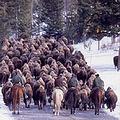 在布希政府任期即將屆滿之際,美國內政部長坎培松(Dirk Kempthorne)於28日宣布一項美洲野牛保育計畫,並成立第二個跨部會小組執行該計畫。
在布希政府任期即將屆滿之際,美國內政部長坎培松(Dirk Kempthorne)於28日宣布一項美洲野牛保育計畫,並成立第二個跨部會小組執行該計畫。
坎培松表示該部門將與州、地方部落和農業的相關組織合作,在野牛管理方面促進合作性的保育活動。另一個跨部會小組已經在執行的《跨部會野牛管理計畫》(Interagency Bison Management Plan),旨在保護黃石公園內的牛群,並透過人為選汰將數量控制在預設範圍內。
美洲野牛曾是地球上單一物種個體數量最多的大型野生哺乳動物,但在1880年代中期因對其毛皮的需求,野牛被獵捕幾近滅絕,族群數量減少至數百頭。
截至今日,北美已有超過50萬頭的野牛棲息在北美的平原之中,大多數為私人所有,僅有不到1000頭被圈養在較小的區域內。
美國內政部現在擁有7000頭野牛,分佈在七個國家野生動物保護區與五座國家公園內。
坎培松表示他將成立一個新的聯邦跨部會小組,使內政部所屬野牛群的管理與研究活動能夠相互配合,並與其他部會完成共同的任務。這個新的小組將由美國國家公園管理局、魚類暨野生動物管理局、農業部、林務局與國防部等五個部門組成。
該工作小組將協助促進、維持野牛群體的遺傳整體性(genetic integrity)。該組也將在2009會計年度舉辦野牛疾病研討會,制定治療野牛疾病的指導方針,建立野牛保育工作的標準作業程序。 坎培松表示工作小組將在「部門的行動中納入部落的野牛專家,並協助部落野牛的倡議。」 該部門希望尋找合作夥伴,在內政部土地開放展示小型野牛群,藉此增加在野牛環保教育上的努力。同時在沒有內政部所屬野牛的地區尋求與動物園合作以完成這些目標。
長年與聯邦政府對抗以保護黃石公園內牧群的野牛保育人士,對於坎培松的新計畫並不意外。
保育團體《水牛田野運動》(Buffalo Field Campaign)的棲地協調委員蓋茲特(Darrell Geist)向ENS記者表示:「儘管坎培茲部長宣布的內容認清了美洲野生野牛保育的威脅,這是好消息,但卻掩飾了內政部在威脅美國野牛最後野生族群所扮演的角色。」
蓋茲特表示,當野牛遷徙到冬季棲地範圍,鄰接黃石公園的蓋勒丁國家森林(Gallatin National Forest)與私人土地時,黃石公園即在園內側設陷阱以捕捉野生野牛。去年冬季有超過300頭野生野牛被強制圍捕、宰殺及隔離,或作為流產疾病布魯氏桿菌(Brucellosis)的抗體測試,標記後野放回園內。
宰殺野牛是依據2000年起實施的《跨部會野牛管理計畫》,該計畫由美國國會提供每年300萬美元的預算,防止野牛遷徙越過黃石公園的邊界而影響在私人或公有土地上覓食的馴養牛隻。
防範布魯氏桿菌威脅也是《跨部會野牛管理計畫》的原因之一。布魯氏桿菌可能從野牛擴散到馴養牛隻身上,進而威脅到蒙大拿州養牛業所維持的無布魯氏桿菌狀態,儘管過去從未有記錄曾發生這類的擴散情形。
In the waning days of the Bush administration, Secretary of the Interior Dirk Kempthorne Tuesday announced a plan to conserve bison, also called buffalo, with a second interagency group.
He said the department will work with state, tribal and agricultural interests to promote cooperative conservation in bison management.
One federal-state interagency group already implements the Interagency Bison Management Plan that keeps the Yellowstone herd within the park and within a pre-set population number through hazing and culling.
Once American bison were the most numerous single species of large wild mammal on Earth. But they were hunted almost to extinction for their skins and were reduced to a few hundred by the mid-1880s.
There are now more than 500,000 plains bison in North America, most privately owned, in herds of less than 1,000 that are fenced within relatively small areas.
The Department of the Interior now manages almost 7,000 bison in seven national wildlife refuges and five national parks.
Kempthorne says he will establish a federal-state interagency working group to coordinate management and science activities related to Interior's bison herds and to carry out cooperative efforts with other parties. The group will include the National Park Service, U.S. Fish and Wildlife Service, U.S. Department of Agriculture, the U.S. Forest Service and the Department of Defense, the secretary said.
The working group is expected to retain and maximize the genetic integrity of Interior's bison herds. The group will convene a bison disease workshop in fiscal year 2009 to develop guidelines and protocols for addressing diseases affecting bison and bison conservation efforts.
Kempthorne says the working group will be "involving tribal bison experts in the department's activities, and assisting with tribal bison initiatives."
The group is expected to increase environmental education efforts on bison by seeking partners to showcase Interior lands with small bison herds, and seek to work with zoos to accomplish these objectives in areas where there are no Interior bison herds.
Bison conservationists who have fought a long-standing battle with state and federal agencies to protect Yellowstone's herd are not impressed with Kempthorne's new plan.
Darrell Geist, habitat coordinator with the advocacy group Buffalo Field Campaign told ENS, "While Secretary Kempthorne's announcement recognizing conservation threats to America's wild bison is welcome news, it glosses over Department of Interior's role in threatening the last wild herd of bison in America."
Geist said Yellowstone National Park operates a trap inside the park interior to capture wild bison as they migrate to winter range on Gallatin National Forest lands and private lands adjacent to the park's boundaries. Wild bison are forcibly rounded up for capture, slaughter and quarantine, or tested for antibodies to the abortive disease brucellosis, tagged and released back into the park, as over 300 bison were last winter.
The bison slaughter is conducted under the Interagency Bison Management Plan initiated in 2000. It is funded at over $3 million dollars annually by the U.S. Congress to prevent bison migration beyond Yellowstone National Park boundaries where some domestic cattle graze on private and public lands adjacent to the park.
Fear that brucellosis might spread from bison to domestic cattle and threaten the Montana cattle industry's brucellosis-free status has been the driving factor behind the Interagency Bison Management Plan, although no such spread has ever been documented.
全文及圖片詳見:ENS




